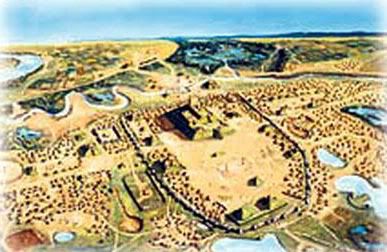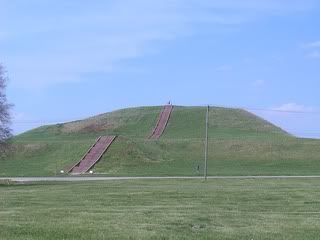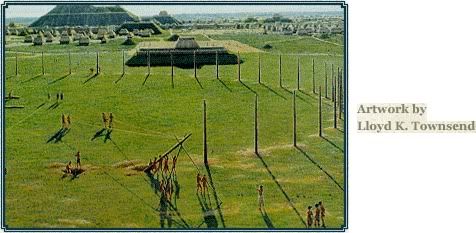A thousand years ago one of the largest cities in the world was located across the Mississippi River from present-day St. Louis. Called Cahokia by archaeologists, we don’t know what it was called by its American Indian builders. A thousand years ago, Cahokia rivaled Paris, Berlin, and London in size.

Cahokia was a part of a cultural complex which archaeologists call Mississippian. There are three outstanding characteristics of Mississippian material culture: tempered clay pottery, square houses, and pyramidal mounds.
With regard to pottery, Mississippian potters tempered clay with pulverized shells in order to increase the strength of pots. This permitted the creation of finer, thinner walled containers. In addition, the increased strength allowed the potters to experiment with new shapes.
The most spectacular characteristic of Mississippian material culture was the construction of earthen pyramids. These pyramids, usually called mounds, have a flat top which provided a space for a ceremonial building or a chiefly residence. Access to the top of the pyramid was made possible by a ramp or stairs up one side.

Monk’s Mound, the central earthen pyramid in Cahokia, is the largest pre-European earthwork in North America. Since Indians did not have pack animals, the dirt required to build this enormous structure was carried by laborers in baskets which held 50 to 60 pounds of earth. Archaeologists estimate that Monks Mound took about 15 million baskets of earth to build.
Monk’s Mound is 1,800 feet long, 710 feet wide, and 100 feet high. It covers 14 acres. This large pyramid was erected in 14 stages over a period of about 300 years: from 900 to 1200. The top of the flat pyramid held a royal residence that was more than 100 feet long and was about 50 feet high.
Construction at Cahokia began about 600 CE and its greatest development occurred between 1050 and 1250 CE. At one point it had an estimated population of 75,000.
Cahokia was made possible by two basic innovations. First, and most important, was agriculture. While Indian people in the Ohio and Mississippi River areas had cultivated some plants for more than a thousand years, the introduction of the three sisters—corns, beans, and squash—made higher populations possible. The alluvial land along the Mississippi is very productive and the competition for the best portions of this land resulted in some warfare between the dominant city states. The second innovation was the bow and arrow, which was used not only as a hunting tool, but also provided some superiority in warfare.
About 800 CE, the people at Cahokia began building a complex which archaeologists call Woodhenge. This was a solar calendar which used a series of wooden posts placed in the ground at certain intervals. The calendar marked the first days of summer and winter, the first days of spring and fall, as well as other special festival dates related to the agricultural cycle.

Cahokia was at the center of a local network of associated mound centers, all located within a day’s walk (25 kilometers) in present-day Illinois and Missouri. In addition, Cahokia was an important node in a large trade, and perhaps political-military, network that encompasses about 52,000 square kilometers.
The material culture at Cahokia and other Mississippian sites indicates a significant change in social organization: there was now social stratification. Unlike the earlier Native American cultures which were basically egalitarian and everyone one had equal access to basic resources, in the Mississippian cultures there were now elite groups who had greater wealth and political power. This was a society which was highly stratified into a series of social classes, with the whole ruled by a supreme chieftain.
When Mississippian rulers died they were often buried with sacrificed individuals. The sacrificial victims were usually women and are commonly assumed to have been retainers or captives but could have included spouses. A village chieftain or ruler may have had a dozen people killed and buried with him.
Some archaeologists have noted similarities between Mississippian culture at Cahokia and the Mesoamerican civilizations of Mexico. These similarities include the practice of human sacrifice, the incorporation of obelisk-like timber posts into their worship, stories of superhuman men and women, the use of Mesoamerican-style flint daggers, and a view of the cosmos in ways similar to those of some Mesoamerican cultures.
One of the things that has puzzled some people is why the large cities such as Cahokia began to decline before the European arrival. The answer to this is relatively simple: the crowding of people into cities along with a lack of efficient waste disposal results in diseases and maladies such as tuberculosis and intestinal parasites. Eventually, the natural fertility of the people could not keep up with the disease mortality and the populations declined.
 Cross Posted at Native American Netroots
Cross Posted at Native American Netroots
An ongoing series sponsored by the Native American Netroots team focusing on the current issues faced by American Indian Tribes and current solutions to those issues.


